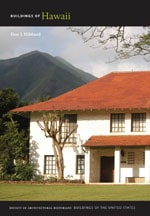
Another unusual architectural experience, at least for Hawaii, sits across from McCoy Pavilion. The meticulously crisp, clean-lined, Art Deco bowling green conveys an ordered tranquility. A five-foot-high, gray, cement brick wall with rounded corners encloses the complex, and four gateways with finely rendered posts and curvilinear wrought-iron gates provide access. The green is a raised lawn area with eight lanes surrounded by a wide walkway of coral pavers. The original pergola has been modified to accommodate a clubhouse and locker rooms. This bowling green was constructed in response to an Australian doctor, who had immigrated to Hawaii and generated sufficient enthusiasm for the game to form a lawn bowling club.
Harry Sims Bent (d. 1959) came to Honolulu to supervise the construction of the C. Brewer Building on Fort Street (OA38). Upon the completion of that project, he decided to stay. A strong proponent for an appropriate regional architecture, he designed the Pine apple Research Institute at the University of Hawaii (OA122.2), Hanahauoli School (1929; 1922 Makiki Street), several parks and playgrounds, and a number of immaculately detailed houses, prior to departing Hawaii with the coming of World War II.

